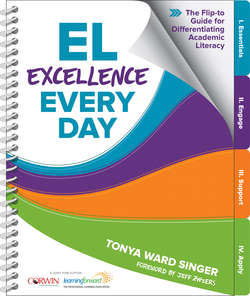Читать книгу EL Excellence Every Day - Tonya Ward Singer - Страница 47
На сайте Литреса книга снята с продажи.
Ways We Might Get Stuck
ОглавлениеBelieving in high expectations for all students and making high expectations a reality are two different things. In theory, it is easy to believe every student can achieve. In practice, it is easy to teach students who currently underperform at low levels. Some of the ways we can easily get stuck include the following:
We Meet Students Where They Are: It’s good teaching to identify where students are currently performing and help them build from their current levels to increasingly higher levels of performance and independent success. The essential word here is build. Sometimes, as I reflected at the opening of this chapter, we can get stuck meeting students where they are without also building from that place to help them thrive with rigorous goals. We do this when we adjust the complexity of our tasks and texts so our students don’t have to struggle or when we overscaffold so students don’t get to apply learning beyond our guidance.
We Protect Students From Struggle: Even if we start with high expectations and challenging tasks, sometimes when students struggle we jump in too soon. We may give an answer instead of letting students figure one out. We may tell students what to do when a prompt may be enough to ignite student problem solving. If students struggle in unproductive ways that lead them to be disengaged, then of course providing immediate guidance, scaffolding, or teaching is important. That said, we must also foster opportunities for students to struggle productively toward ambitious goals. Teaching with high expectations requires both a strategic use of scaffolds and giving students the think time and trial-and-error opportunities needed to solve problems and make meaning through rigorous tasks and texts.
We Sort and Track Students: With the intention of addressing specific needs, schools often sort and track students in ways that hinder the learning of underperforming students (Noguera, Darling-Hammond, & Friedlaender, 2015). ELs are often removed from core teaching to engage in low-level, disconnected language instruction. To learn and excel with the academic language essential for content success, ELs need to engage daily in speaking, listening, reading, and writing across the core curriculum. To excel with rigorous academic content, ELs need to access and engage with rigorous academic content. Flip to Chapter 4, pages 86–107, for flexible strategies to differentiate that don’t involve tracking.
